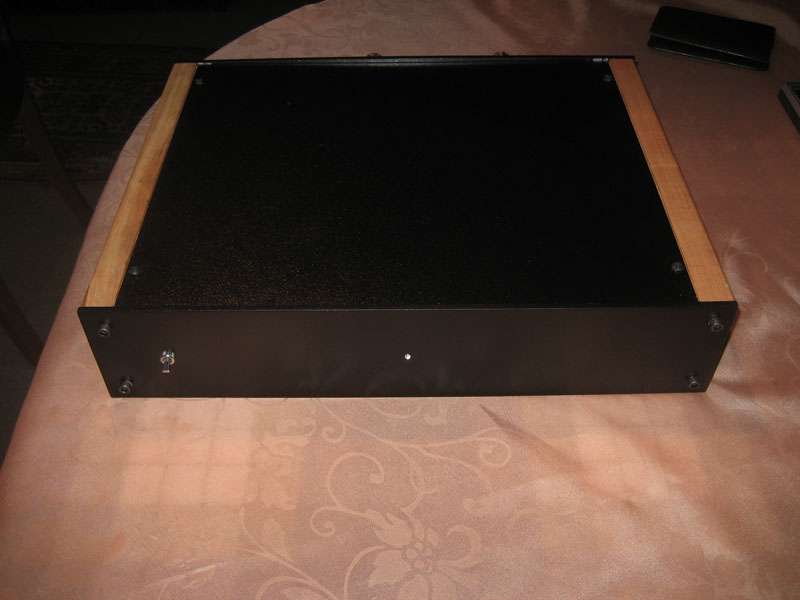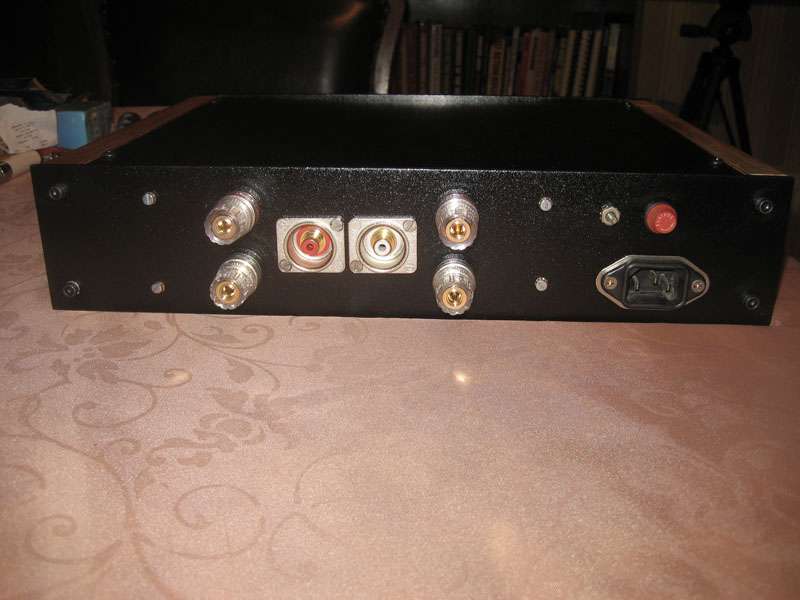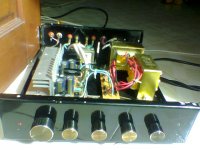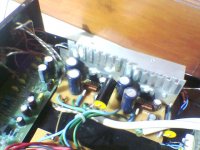Gain Clone with LM1875
Inputs selectable via push button on front panel - switching + memory function using 16F629 PIC.
/R
Inputs selectable via push button on front panel - switching + memory function using 16F629 PIC.
An externally hosted image should be here but it was not working when we last tested it.
An externally hosted image should be here but it was not working when we last tested it.
An externally hosted image should be here but it was not working when we last tested it.
/R
LM4780TA..
Home made PCB:
AMP:
Some modifications:
Home made PCB:
An externally hosted image should be here but it was not working when we last tested it.
An externally hosted image should be here but it was not working when we last tested it.
AMP:
An externally hosted image should be here but it was not working when we last tested it.
Some modifications:
An externally hosted image should be here but it was not working when we last tested it.
An externally hosted image should be here but it was not working when we last tested it.
My latest and best so far. Three LM3886s in parallel per channel with PSU on the same board. Board size is 100mm by 100mm for the lot (mono). Just connect a transformer, input and output and you're off 🙂
I am really proud of it because it works with minimal grounding effort, no hum or buzz to be heard and only a very faint hiss from less than 1cm away.
No case yet. That's the next thing. It's going to be made out of real wood though. I'm getting help with it, because I am useless with power tools 🙄 I've also got a PIC controlled push button (made to switch a relay on and off) to go with it, with a fading power LED (ring around the power button).
Yay or Nay? 🙂
I am really proud of it because it works with minimal grounding effort, no hum or buzz to be heard and only a very faint hiss from less than 1cm away.
No case yet. That's the next thing. It's going to be made out of real wood though. I'm getting help with it, because I am useless with power tools 🙄 I've also got a PIC controlled push button (made to switch a relay on and off) to go with it, with a fading power LED (ring around the power button).
An externally hosted image should be here but it was not working when we last tested it.
An externally hosted image should be here but it was not working when we last tested it.
Yay or Nay? 🙂
Great stuff Markiemrboo - surely a YAY for construction. 
Please provide your impression after listening tests.
Do you plan to publish/share the board construction files? Please?
Cheers,
LS

Please provide your impression after listening tests.
Do you plan to publish/share the board construction files? Please?

Cheers,
LS
wim said:Very, very nice work markiemrboo !!
How does it sound?
Thanks wim!
I'm just testing it at the moment to make sure nothing bad happens. They are my old speakers, 4 ohm nominal Eltax Monitor IIIs. It seems to drive them very well indeed though. The rectifiers stay stone cold, the heatsink gets fairly hot, but I can keep my hand on it for 10 seconds+ pretty easy.
I seem to remember that using these speakers with my current amp (regulated single LM3886) and old Cambridge Audio A5 on particularly bassy tracks the woofer would give up and start making clunky noises. With this amp it seems to behave much better with the same tracks. Obviously the poor little woofer still has it's limits though.
dudaindc said:Great stuff Markiemrboo - surely a YAY for construction.
Please provide your impression after listening tests.
Do you plan to publish/share the board construction files? Please?
Cheers,
LS
Thanks dudaindc!
I will try. I am really not good at describing sound though. I probably also need to calm down a bit. I am so excited that it's working so amazingly well, and is so neat compared to previous attempts
 I can't turn it off. I set out to test it for an hour and it's been on all day!
I can't turn it off. I set out to test it for an hour and it's been on all day!I will post the layout soon. I've got a fair bit on my plate at the moment so it won't be instantly! It's oriented towards home made PCB construction though, with blobs of trace around smaller holes (i.e small resistors) so that drilling doesn't lift the traces as easily. I'm not sure how well the layout will work when sent off to a pro place either. Maybe someone can give hints when I eventually post it 🙂
Dennis5587 said:markiemrboo, how much power does that amp put out?
I don't have the means to actually test it, but I think (probably quite wrong?) given an adequate heatsink and power supply... it's capable of something like, per channel:
8 ohms - 50W RMS continuous average, 100W peak
4 ohms - 100W RMS continuous average, 200W peak
I'm not sure about 2 ohms. If it was a 2 ohm resistive load then could it manage something like 28Vpk = 14Apk? 14A / 3 (chips) = 4.6A per chip, which is well below the 7-11A limit of the LM3886. That equates to 400W peak / 200W "RMS" in to 2 ohms though, which just seems a bit unrealistic
 I can't help but feel that I am missing something with power ratings as large as that from a chip amp....
I can't help but feel that I am missing something with power ratings as large as that from a chip amp....Power ratings still do confuse me a bit 🙂 I'm fairly sure the first two (8/4R) are realistic though. AndrewT did some calculations for me a while back and concluded that it should be able to cope with the most evil of 4 ohm speakers, but wouldn't recommend trying a 2 ohm speaker.
my amp (2xLM4780TA for one chanell) puts 125W RMS on 8ohms (tested) i think it's enough for me
4ohms not tested yet...but i think it's about 230-250W rms.. 🙂
4ohms not tested yet...but i think it's about 230-250W rms.. 🙂
Dielkius said:my amp (2xLM4780TA for one chanell) puts 125W RMS on 8ohms (tested) i think it's enough for me
4ohms not tested yet...but i think it's about 230-250W rms.. 🙂
Is that a bridged configuration? Sounds good. I think I might also give that a go when I get this amp a case and redo my preamp.
With regards to how mine sounds....
Today I have ripped my old amp, LM338 / snubbered / single LM3886 per channel, out of it's case and placed the new one in to test with my usual speakers, a pair of lowly Celestion 7's.
I shall start by saying that I am not a big believer in amplifiers and such making differences to the sound, so this is purely subjective and may well just be because I am happy it works etc etc etc.
Initial impressions are that bass lines seem very easy to follow, possibly what some might refer to as tight and well controlled. Midrange and treble seem to be sounding really quite lovely. There does seem to be detail that I haven't heard before. Airy echoes and midrange stuff. There is a certain delicateness about it that is just magic. I haven't noticed much of a change in imaging / sound stage etc.
I've just got the house free to myself for a bit and have had a chance to test briefly (I do like my hearing, so I dont tend to listen loud for long) how well it copes "under load". It is also an improvement, much to my surprise! I can turn the volume all the way and it still sounds very clean! The bass seems to have way, way more punch to it, very noticeable. I can actually feel it now...
Very cool! I know it's not much to go on, but subjectively I have to say it does sound nice. Hope that satisfies some curiosity for now 🙂
Today I have ripped my old amp, LM338 / snubbered / single LM3886 per channel, out of it's case and placed the new one in to test with my usual speakers, a pair of lowly Celestion 7's.
I shall start by saying that I am not a big believer in amplifiers and such making differences to the sound, so this is purely subjective and may well just be because I am happy it works etc etc etc.
Initial impressions are that bass lines seem very easy to follow, possibly what some might refer to as tight and well controlled. Midrange and treble seem to be sounding really quite lovely. There does seem to be detail that I haven't heard before. Airy echoes and midrange stuff. There is a certain delicateness about it that is just magic. I haven't noticed much of a change in imaging / sound stage etc.
I've just got the house free to myself for a bit and have had a chance to test briefly (I do like my hearing, so I dont tend to listen loud for long) how well it copes "under load". It is also an improvement, much to my surprise! I can turn the volume all the way and it still sounds very clean! The bass seems to have way, way more punch to it, very noticeable. I can actually feel it now...
Very cool! I know it's not much to go on, but subjectively I have to say it does sound nice. Hope that satisfies some curiosity for now 🙂
markiemrboo said:
Is that a bridged configuration? Sounds good. I think I might also give that a go when I get this amp a case and redo my preamp.
its BPA..
Hello
My Gainclone, based on Chipamp.com LM3886 kit. Build as a simple power stage and connected to a lovely Nakamichi 410 vintage preamp.
Trafo is AnTek AN-2225 (200VA, 25+25V) primary was series wired for chilean 220V mains.


My Gainclone, based on Chipamp.com LM3886 kit. Build as a simple power stage and connected to a lovely Nakamichi 410 vintage preamp.
Trafo is AnTek AN-2225 (200VA, 25+25V) primary was series wired for chilean 220V mains.
An externally hosted image should be here but it was not working when we last tested it.


flamberge said:Hello
My Gainclone, based on Chipamp.com LM3886 kit. Build as a simple power stage and connected to a lovely Nakamichi 410 vintage preamp.
Trafo is AnTek AN-2225 (200VA, 25+25V) primary was series wired for chilean 220V mains.
Nice work. I like the DIY enclosure.
flamberge said:Hello
My Gainclone, based on Chipamp.com LM3886 kit. Build as a simple power stage and connected to a lovely Nakamichi 410 vintage preamp.
Trafo is AnTek AN-2225 (200VA, 25+25V) primary was series wired for chilean 220V mains.
Nice work! 😀
Nice but?
Another nice job but with the heatsinks inside the box!
Where is the heat going to go?
Frank
Another nice job but with the heatsinks inside the box!
Where is the heat going to go?
Frank
- Home
- Amplifiers
- Chip Amps
- Chip Amp Photo Gallery


